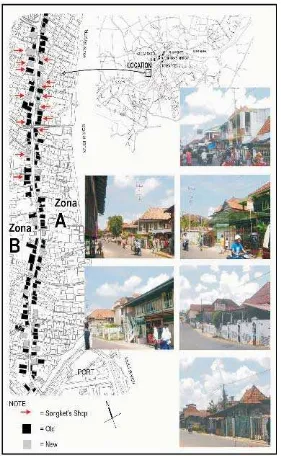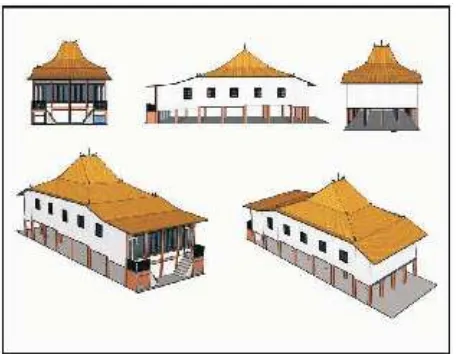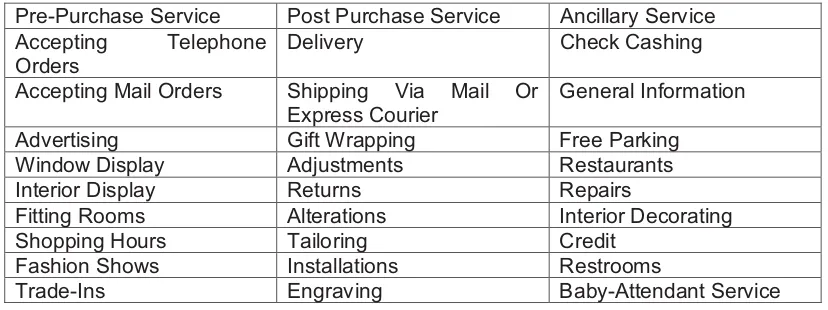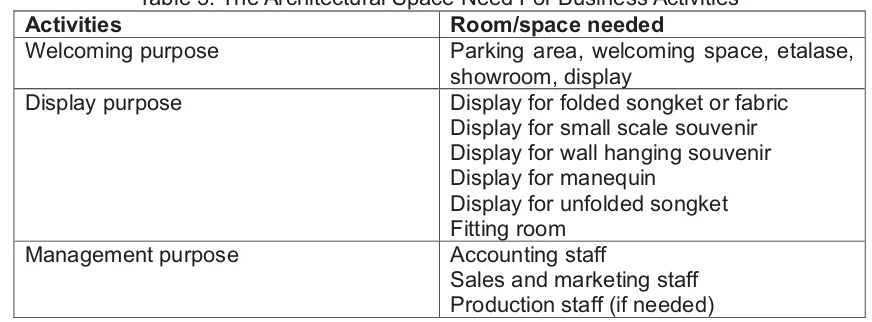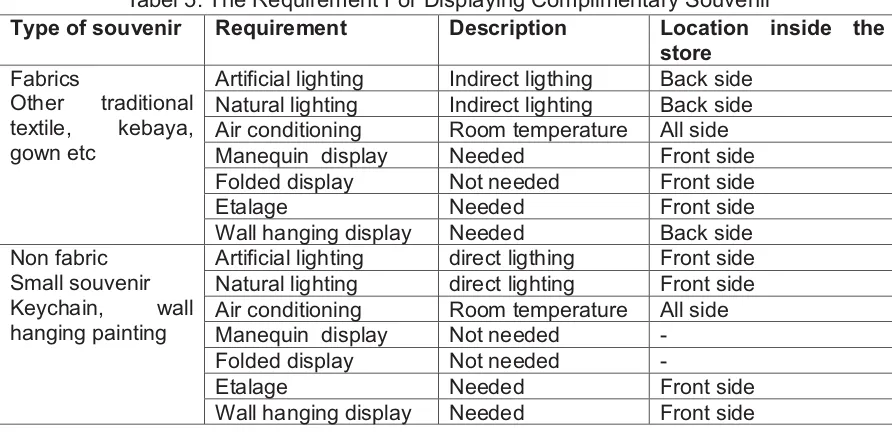Proceedings
International Conference
Arte-Polis 2
Creative Communities
and the Making of Place:
Sharing Creative Experiences
Bandung, 8-9 August 2008
Proceedings
Arte-Polis 2 International Conference
Creative Communities and the Making of Place: Sharing Creative Experiences Bandung, 8 - 9 August 2008Woerjantari SOEDARSONO, Dr.
Prof. Lily KONG, PhD (NUS - Singapore) Em.Prof. Mohammad DANISWORO, PhD (PSUD & ITB - Indonesia) Prof. Surna T. DJAJADININGRAT, PhD (ITB Indonesia) Prof. Setiawan SABANA (ITB Indonesia) Armein Z.R. LANGI, Ph.D. (ITB Indonesia) Himasari HANAN, Dr.-Ing. (ITB - Indonesia) Indra B. SYAMWIL, PhD (ITB - Indonesia) Basauli Umar LUBIS, PhD (ITB - Indonesia) Ismet B. HARUN, Dr.Eng. (ITB Indonesia) Rini RAKSADJAYA, Dr. (ITB Indonesia) Ahmad Rida SOEMARDI, MArch. MCP (ITB - Indonesia) Achmad D. TARDIYANA, MUDD (ITB - Indonesia)
Ahmad Rida SOEMARDI, MArch. MCP.
Dr.Eng. Arif Sarwo WIBOWO Alvanov ZPALANZANI, ST., MM. Dan COHEN Head, Arte-Polis Organizing Committee
Reviewers
Editor
Editorial Team
Institute of Technology, Bandung Architecture SAPPK ITB SBM ITB PP-SRD ITB PP-TIK ITB
Department of Architecture School of Architecture, Planning, and Policy Development Institute of Technology, Bandung
Jl. Ganesha 10, Bandung, INDONESIA Tel. +62-22-2504962, +62-22-2530706 Fax +62-22-2530705 ISBN: 978-979-18399-0-7
Copyright and Reprint Permission All rights reserved. This book, or parts thereof, may not be reproduced in any form or by any means, electronic or mechanical, including photocopying, recording, or any information storage and retrieval system now known or to be invented, without written permission from the Organizer.
All rights reserved. © 2008 by
INTRODUCTION
The second Arte-Polis International Conference taking place at the Institute of Technology Bandung (ITB) on 8-9 August 2008, underlines the importance of discourse on creative communities that puts significant impact on the making of places. Its aim is to critically debate and develop creative communities as the basis for a paradigm shift in the cultural economy that influences the formulation of policy in development. Under the main theme of “Creative Communities and the Making of Place”, this two-day International Conference elaborates the praxis of place-making that reflects the potential of human creativity in the built environment.
A series of papers are presented, which elaborate this main theme within six parallel sessions. In this publication, the Keynote and Featured speeches along with Parallel Session papers are compiled to provide an insight for reflection and sharing of best practice experiences from over 16 countries. It offers an overview of the topics raised and a platform for discussion by Conference participants. We trust that you will find this second Arte-Polis International Conference on Creative Communities and the Making of Place, in our idyllic campus of ITB, a rewarding and enriching creative experience worth sharing.
The Arte-Polis 2 Organizing Committee
Contents
Introduction
Content
Keynote Speakers
Featured Speakers
Parralel Session iii
iv
I-01
II-01
0
0
0
0
0
0 s
A. Architecture & Environmental Designs for Creative Communities A- 1
B. Business, Management and Entrepreneurship for Creative Communities B- 1
C. Cultural Arts & Design of Creative Communities C- 1
D. Digital-Media & Information Technology for Creative Communities D- 1
E. Education & Theoretical Discourse on Creative Communities E- 1
F. Planning & Policy Development for Creative Communities F- 1
iii
iii
iii
Keynote Speakers
Lineages of The Creative City
LANDRY I-02
ANGESTU I-11
Charles
Mari Elka P , PhD.
Creative Economy Policy in Indonesia iiiiii
Parallel Sesion A
Architecture & Environmental Design
for Creative Communities
The Semiotics of Architecture and Visual Art at The Toraja Tongkonan: Reflecting The Ancestor’s Conduct of Life
The Architectural Response of Traditional Building in Making the Place for Tourism-Business Activities. Case-study: Ki Gede Ing Suro Street, Center of Songket Handicraft Industry
Sustainable Tourism in Urban Context. Case-study: Melayu - Colonial Corridor in City of Medan
From Design Process to Process Design: Lessons-Learned from Collaborative Urban Resettlements in Post-Disaster Recovery
Enhancing the Quality of Life of Disabled Women through Creative Industry: A Perspective on Creative Communities
Flexibility of Spatial Function for Activity of Industry Kampong Community in Bandung. Case-study: Knitting Industry Binong Jati, Bandung
Yuke ARDHIATI A-003
Widya F. FEBRIATI A-008
Nurlisa GINTING A-016
Bauni HAMID A-022
Inge KOMARDJAJA A-032
Dian KUSBANDIAH & Woerjantari SOEDARSONO A-040
Users' Place Experience of a Contemporary Masjid towards Urban Place-Making in Singapore
Amira MOHYUDDIN & Hasanuddin LAMIT A-049
A-02
Contribution of Creative Advertising and Creative Economy in Deteriorating Urban Place-Making: Case-Study Medan City Center
Less Consumption Places for More Creative Community
Using Participatory Rural Appraisal to Investigate the Role of Women in Micro-Business: Case-study in Aceh after Tsunami
Human Settlements and Creative Industry. Community’s Production Activities at Cipacing & Binong Jati and their Settlement: A Comparative Study
Comparison Study: The Impact of Bandung's Fashion Creative Economy to Suci and Binong Jati Physical Environmental Quality
Creative Spaces on Affordable Vertical Housing (Rusun): A Sharing Experience
Place-Making in Unused Urban Space
Creating the Open Space's Sense of Place. Case-study: Deli’s Sultanate Area
A New Characteristic of Colonial House in Kudus
A. Delianur NASUTION & Wahyuni ZAHRAH A-058
Ece POSTALCI ALTINKAYA & Imre OZBEK EREN A-064
Wirawan E.D. RADIANTO A-071
SAMSIRINA, Allis NURDINI & SYAHYUDESRINA A-077
Woerjantari SOEDARSONO A-087
Deva F. SWASTO A-093
Julaihi WAHID A-101
Julaihi WAHID & Bambang KARSONO A-106
Arif S. WIBOWO A-112
THE ARCHITECTURAL RESPOND OF
TRADITIONAL BUILDING IN MAKING THE PLACE
FOR TOURISM-BUSINESS ACTIVITIES
STUDY CASE: KI GEDE ING SURO STREET,
CENTER OF SONGKET HANDICRAFT INDUSTRY
Widya Fransiska FEBRIATI
ABSTRACT
NTRODUCTION
Departement of Architecture, Sriwijaya University - INDONESIA
I
As mentioned in South Sumatra tourism development master plan, the importance effort to recognize and introduce the genuine character of South Sumatra culture bring a logical consequences to build up the tourism product development strategy. This strategy was made based on the riverwaterfront potency which becomes the main image and selling point of south Sumatra tourism. In line with the concept of widyafrans@telkom.net
Ki Gede Ing Suro Street at 30 Ilir, in Palembang is well-known as center of songket production place. In line with the local government tourism program, the tourism activities created the need of place and space for presenting and selling songket along the street. These also created the changes for economic social activities and physical environment. Those are addressed to increase the sales number of songket.
The street is located at one of old districts where the traditional building type, Limas, could be found. These houses were owned by the local people and functioned as place to live, to produce and to sell songket (as showroom /small store). The buildings which functioned as store located along the street and created specific romantic value to the street vista. For now on, the romantic view still could be found although the number of old buildings was not as much as before. The number of new modern constructed building had increased, and these new ones were not designed contextually to the olds. The condition would lead to losing or declining value of traditional architecture and further could eliminate the attractiveness of Ki Gede Ing Suro corridor as tourism destination. The facade of buildings along the street will have no further meaning but the series of modern showroom or small stores. The taste of Kampong Songket will be gone.
This paper will discuss more about effort to minimize the declining romantic value of traditional architecture in Kampong Songket. This paper is aimed to propose a set of recommendation of physical changes on traditional buildings which have performed as songket store or showroom. The discussion will conducted by analyze the aspect of marketing strategy of songket as retail business and the architectural effort to answer the need of business activities. The discussion was limited on Place (one of 4P's marketing mix), especially service and atmosphere decision. The marketing analysis would be combined with the architectural space analysis to fulfill the need of making place and space for songket business activity.
handycraft industry, limas, songket
Keywords:
A-09 tourism promotion, the development of tourism product included the object and the
attractiveness should be comprehensive with marketing activities (Wahab,1997)
Songket has been known as souvenir from Palembang. It is a small part of tourism product that should be developed for support the south sumatera tourism, especially palembang. The romantic of songket and old housing located along musi river have a high value of tourism attrasctiveness.
The process of making songket, called menenun, is a common activity done by women from teenanger to the adults. This activities was proposed to fulfill the need of fashion. The changes of situation happened has also changed the proposed of making songket, from fulfilling the need of fashion to tourism business (in line with the use of songket as spesial high class of souvenir form palembang) Some of the craftwomen sell the songket to the whole saler or distributor who have higher capital, and some of them sell songket by themselves. One of the location for songket outlet was chosen at the Ki Gde Ing Suro Street which is the main street in this settlement.
The Ki Gde Ing Suro (KGIS) Street is located along the musi riverside. The KGIS is a part of Palembang- old city, and it is located near by the center of old trading area in Palembang. There are many traditional old building located along the street. The street was continued with the Pangeran Sedo Ing Lautan street, which has many traditional buildings too. By looking the
A-10 building structure, it can be concluded that the former function was house or dwell not as
business outlet or store.
Limas is one type of traditional building located along the KGIS street. It is known as identity of south sumatera traditional building, especially traditional building of Palembang. Generally, it is owned by local Palembangnese or the one who has a relative higher social position in community.
The spatial order of Limas consists of three zones. First zone is the public area, named Bengkilas. Bengkilas has at least four different floor level or split level (kekijing). It usually use as formal living room and formal place for ceremonial events. Secone one is Pedalon. It is a private area which consists of one up to three bedrooms. The last one os Pawon, which is service area. Pawon could be seperated from main building for some limas building.
The fasade of limas was dominated by the form of roof style. The front side of Limas is named tenggalong or lawang kerang. It is a transparant vertical wall which is made from a series of small long wood. Tenggalong is used as border of fence, protect user from outside of building, and vertikal ventilation. Behind the tenggalong, there is a transitional area named bengkilas bawah. It has the same function as terrace. Above the bengkilas bawah, there are series of flat wooden wall, called lawang angkatan or lawang kipas. At the middle part of lawang kipas, there is lawang borotan, which is used as ordinary door/entrance.
Retailing includes all the activities involved in selling goods or services directly to final customer for their personal, non business use. A retailer of retail store is any business enterprise whose sales volume comes primarily from retailing. Retail can be a small or big customer. There is much type of retailers, generally namely: specialty store, department store, supermarkets, convenience store, discount stores, off-price retailers (factory outlets, warehouses), superstores (combination stores, hypermarkets). Songket store can be categorized as specialty stores.
Specialty stores can be defined as a type of retailer which carries a narrow product line with a deep assortment within that line: apparel stores, sporting-good stores, furniture stores, florists, bookstores. Specialty stores can be sub classified by the degree of narrowness in their product line. A clothing store would be a single-line store; a songket store would be a super specialty store.
In order to take advantage of increasing opportunities for market segmentation, market targeting and product specialization, retailer must have clear marketing strategies decision. One of those is creating selling image through creating appropriate store atmosphere. This decision is known as Services and store atmosphere decision. (Kotler, 1997, p.576). This includes a synergy and comprehensive marketing decision among pre purchase, post purchase and ancillary service for buyer. Retailers must also decide on the service mix to offer customer, the table below lists some major services that full-service retailers can offer. The service mix is one of the key tools for differentiating one store from another.
THEORITICAL BACKGROUND The architecture of Limas
As shown in the next table, it is clearly shows that the store atmosphere is another important element in retailing. Every store has its physical layout that makes it hard or easy to move around in. Every store has a “look” and 'image'; one store is dirty, another is charming. The store must embody a planned atmosphere that suits target market and draw consumer toward purchase.
Table 1. Typical Retail Services
As shown in table above, it is clearly shows that the store atmosphere is another important element in retailing. Every store has its physical layout that makes it hard or easy to move around in. Every store has a “look” and 'image'; one store is dirty, another is charming. The store must embody a planned atmosphere that suits target market and draw consumer toward purchase.
There are many traditional buildings located along the KGIS street. The buildings' location was paralel to the river path. The buildings' formerly functioned was dwellings or housing. The general buildings fasade are dominated by old type traditional building. By comparing the dimension among the streets located around , it is clearly seen that KGIS was a main street in the past time. Up to now, KGIS street is still function as the building orientation as it position as main street.
The songket showroom/ store were mostly located from the cross section of Ki Gde Ing Suro street and Ki rangga wirasentika street to pangeran sido Ing lautan street. Along this part of street, there are two function of building can be found, namely housing and business (small, medium and high business scale). The small business activities are placed at a relatively small part of building, such warung (small vendors), wartel (small vendor for public telephone), etc. On the other side, the medium and high scale are placed at a relatively bigger space, and mostly are handled in buildings (store or showroom). The songket store is dominant for this business scale. Because of this, the image of a center of songket industry is shown clearly by the series of songket store/showroom buildings. There are two types of store/showroom building, the old-traditional one and the new-constructed one. The comparasion of building function is showns as followed.
Table 2. The building function
Source: Kotler, 1997, p.576
Source: Survey, 2008 DISCUSSION
A-11
Pre-Purchase Service Post Purchase Service Ancillary Service Accepting Telephone
Orders
Delivery Check Cashing Accepting Mail Orders Shipping Via Mail Or
Express Courier
General Information Advertising Gift Wrapping Free Parking Window Display Adjustments Restaurants Interior Display Returns Repairs
Fitting Rooms Alterations Interior Decorating Shopping Hours Tailoring Credit
Fashion Shows Installations Restrooms
Trade-Ins Engraving Baby-Attendant Service
Function House Songket Store/ showroom
Building type
Old traditional 24 3
Respond To Business Activities
Respond To Product Sold
Business activities for souvenir related to tourism business activities. From the kotler's theory, it can be concluded that in order to create the suitable atmoshphre for ratail business, the store management shold make a physical creation/changes of store.
From architectural space, the possible changes/ creation should fulfill or accomodate at certain spaces as follows.
Table 3. The Architectural Space Need For Business Activities
As mentioned above, the songket store/showwroom building can be a building with traditional style, as reaction of building function changes, and the one with new modern style. The one with traditional style builds its own character, as respond for fulfilling tourism businees activities, as shown in following table.
Table 3. The General Existing Respond Of Old Traditional Building
Songket is specific high class product, as it is made by using a high concentration human skill. The high level of difficulties in making songket make the product has high economic value and so do the image. The nature characteristic of songket was specific too. It has to be store at special place with specific requirement such as level of lighting, space order, air conditioning,etc. Because of that, the store display must meet some requirement to keep the quality of songket.
Generally, the store/showroom display songket in a long rolled form with approximately 1.20 cm in length. The rolled songkets were displayed in glass covered cabinet. Usually the cabinets were placed in backside of store (more than three metres from the main entrance). It is propose to protect the songket from direct sunlight and direct hot temperature that can damage the quality of songket.
The display for songket using manequin was not common. Usually the store use manequin to display complemetary souvenir-product such the kebaya, gown, man-shirts, and other
Source: Analysis
Source: Analysis
A-12 Business activities Space provided
Welcoming area for tourist Available Parking area None Sitting place for tourists None Ētalage Display manequin Avaiable Ētalage for folded fabric Available Fitting room None Songket showroom Available
Accounting and management room Not highly provided SPG or marketing staff Not highly provided
Activities Room/space needed
Welcoming purpose Parking area, welcoming space, etalase, showroom, display
Display purpose Display for folded songket or fabric Display for small scale souvenir Display for wall hanging souvenir Display for manequin
Display for unfolded songket Fitting room
Management purpose Accounting staff
traditional fabric such jumputan, tajung etc. Manuequin with the those product on were placed in front of store, in certain place such etalage, or indoor display.
Tabel 4. The Requirement For Displaying Songket.
Besides the fabrics, the souvenir store also sell some small souvenir product which were made from the songket such tanjak and kopjah (traditional hat use for man), wallet from songket, key chain, traditional dressed groom and brides miniature, and so forth. Those small souvenir were displayed at front area of store.
Tabel 5. The Requirement For Displaying Complimentary Souvenir
In the past time, Musi river was the main orientation of people. All the activities use river as main orientation, and so do the buildings. Along with the city development, the land were developed and people used street as circulation path. The orientation of building was changed from the river to the land (street). This changes created the changes of new building orientation. The buildings changed its orientation to the street, some of them still used the river as orientation. The changes were happened to building with location between the street and river (zone A). Meanwhile the building located in opposite side (zone B) did not change the orientation because the street and the river (as orientation) were in the same direction.
Related to tourism business activities, the changes above make changes to zoning area. The private/ service zone of traditional buildings in zona A become public zone. The bedroom (private) and kitchen (service) transformed in to public (as main entrance, and store). In zone B, the zoning changes were not happened. Public zone for living room or main entrance were still functioned as public, but with additional function as store.
Source: Analysis
Source: Analysis
ARCHITECTURAL CHANGES OF TRADITIONAL BUILDING Zoning Changes
A-13
Requirement Description Location inside the store
Artificial lighting Indirect ligthing Back side
Natural lighting Indirect lighting Back side/ Shadowed area Air conditioning Room temperature All side
Manequin display Not highly needed Backside
Folded display Not needed
-Etalage Special etalege needed Backside Wall hanging display No highly needed Back side
Type of souvenir Requirement Description Location inside the store
Artificial lighting Indirect ligthing Back side Natural lighting Indirect lighting Back side Air conditioning Room temperature All side Manequin display Needed Front side Folded display Not needed Front side
Etalage Needed Front side
Fabrics
Other traditional textile, kebaya, gown etc
Wall hanging display Needed Back side Artificial lighting direct ligthing Front side Natural lighting direct lighting Front side Air conditioning Room temperature All side Manequin display Not needed
-Folded display Not needed
-Etalage Needed Front side
Non fabric Small souvenir Keychain, wall hanging painting
Fasade changes
RECOMMENDATION OF ARCHITECTURAL RESPOND
Recomendation for Building
Recomendation for urban design
As mentioned above, the store was additional function of traditional house. Because its additional process, the changes of building happened spontanouesly without considering the potency of traditional architecture. Songket retailers generally did some additional action in fulfiliing the need of songket store, such using the lower ground of house (formerly open space under the house), or reconstructing the building become new one with new modern construction. Those action would bring the decline quality of architectural image of traditional house, more over, the traditional kampong. Because those changes made changes in fasade of traditional buildings.
In order to eliminate the declining quality of traditional building, there are some recommendation in transforming traditional building into songket store as follows:
1. As the changes of building orientation, the zoning change would not create a strongly recomendation of building physical changes. It can be solved by provide transitional area as welcoming area of the store. By doing so, the service area (which was backside of building) can be transformed into public area (which was functioned as welcoming area)
2. There is no need to use front etalage (glass covered) for the store, as the character of selling product. The display area can be accomodated in backside of the store,especially the traditional fabric (songket,jumputan etc.) This will create higher image of product, with its elite personal service for buyer.
3. There is no need effort to make another open ventilation or window as the songket product need normal-indirect natural lighting. The insufficient natural lighting can be fulfilled with normal artificial lighting.
4. Management area (such hrd, accounting staff) can be placed at the front side of the store with indirect access from and to welcoming area. In other hand, the sales/marketing staff sholud be placed at transitional area so they can service and bring the buyer to the display room, at the backside of building.
5. The production area can be accomeodated in two ways. Firstly, it can be placed at display area, as it represent songket production process for educating the market. Other prodution process should be placed at other side of building with idirect acces to/from display room. 6. Because of the product charater and the created image, there is no need to change the
traditional face of building. The image of product, the atmosphere of traditional souvenir retail are become stronger by having the traditional style just the way it is.
1. Every business has its own identity as a part of marketing effort. Every store has its ownidentity, and the group of store existence would create region identity. Responding the business activities in tranditional style building, the board name of store must not damage the traditional appereance of building.
2. In order to show business identity, there must be a special design for sign board/ advertisement board for store. The design should accomodate the individual identity of the store and further more it must signify the songket industry region identity. The designs can be applied on fences, gate of house yard, gate of region and so on.
3. In line with the conservation effort to eliminating the declining architectureal potency of traditional building, the building regulation must be provided by official local goverment. This regulate the permisiable effort to renovate traditional building. This regulation is addressed to those traditional buildings which have not been transform in to new funstion or new fasade, specially building licated along the Pangeran Sedo Ing Lautan street. For building that have been transform pr changes in to new modern face, the regulation will direct the retailer to reconstruct the fasade in to new-traditional imaged building.
BIBLIOGRAPHY
Kotler, Philip (1997), ,
9th edition, 1997, Prentice Hall, USA Saragih, Meriati, et.al (2002),
, Dinas Pendidikan Nasional.
Wahab, Salah, et.al (1997), , edisi terjemahan,
Jakarta .... (2004),
, Dinas Kebudayaan Dan Pariwisata Provinsi Sumatera Selatan
Marketing Management, Analysis, Planning, Implementation And Control
Buku Panduan Museum Negeri Sumatera Selatan, Proyek Perbaikan Museum Sumatera Selatan
Pemasaran Pariwisata, Pradnya Paramita
Laporan Akhir Penyusunan Rencana Pengembangan Obyek Dan Daya Tarik Wisata Provinsi Sumatera Selatan
